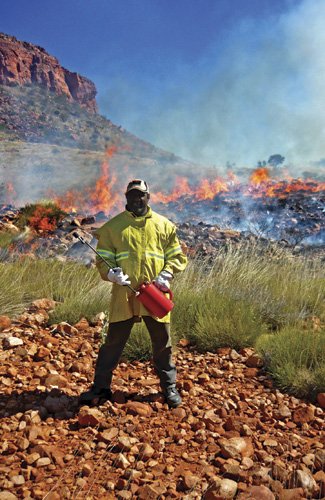Aboriginal desert reserve bigger than Tasmania

ABORIGINAL PEOPLE FROM the Tanami Desert in Central Australia are celebrating after the government signed off on the creation of a conservation area larger than Tasmania to be managed by indigenous rangers.
At a ceremony in the remote outback location of Sangsters Bore, about 600km northwest of Alice Springs in the Northern Territory, dozens of traditional owners were on hand to welcome the move.
“Today is an emotional day. Today really a freedom day,” said Eddie Jampijinpa Robertson, a Warlpiri elder from Yuendumu, on Tuesday. “When we look after the land, it is what our Dreaming is.”
Southern Tanami Indigenous Protected Area
The 101,500sq.km Southern Tanami Indigenous Protected Area (IPA) forms part of the Trans-Australia Eco-link conservation corridor, which stretches from Arnhem Land to the Great Australian Bight, more than 3500km away.
The new conservation zone is the largest single chunk of land area ever dedicated to conservation in Australia and stretches from deserts to subtropical savannahs.
It is about the size of Portugal or 30 per cent bigger than Tasmania, and takes in a large part of the Tanami Desert and a small part of the Great Sandy Desert.
The IPA means Aboriginal people will have more say in how the land is cared for, culturally and environmentally.

Fire is used to protect rock wallaby habitat in the Southern Tanami IPA. (Credit: Central Land Council)
Indigenous ecological knowledge
The Federal Government will spend $1.6 million over the next two years to fund local rangers to look after the Southern Tanami region, and philanthropic group The Nature Conservancy is also spending $500,000 to help manage the area.
“In this IPA, Warlpiri rangers will combine science with Indigenous ecological knowledge to deliver new solutions to challenges around issues such as fire management, feral animals, and weed control,” said the Nature Conservancy’s Peter Taylor. “But it will also ensure that indigenous knowledge and culture is kept alive and that areas of high conservation significance are protected against new threats.”
Federal Indigenous Health Minister Warren Snowdon said the new conservation area would be an example to all of Australia about how the land can be properly cared for. “What it says to the Australian community across the country is that not only are we responsible, but we know what to do to look after our country,” he said.
IPA protects Warlpiri Aboriginal culture
Traditional owner Lottie Robertson said the decision was the result of five years’ work and would ensure her people’s knowledge was passed down to the next generation. “The Southern Tanami belongs to Warlpiri people,” she told the crowd on hand to welcome the announcement. “We now have young rangers who learn to look after country.”
Chair of the Central Land Council, Phillip Wilyuka, added that the IPA signalled a change from how indigenous people had been treated by Australian governments in the past. “I guess the non-indigenous people have had to learn from Aboriginal people how to look after this country,” he said.
The IPA is an area that is rich in rare Australian species, such as the princess parrot.
A statement from the Nature Conservancy said “[the IPA] includes two internationally important sites for conservation – the southwest Tanami Desert and Lake Mackay. The ancient land contains habitat critical to the survival of many of Australia’s threatened species, including the bilby, mulgara, and great desert skink. Southern Tanami also includes important wetlands, breeding sites for waterbirds, and rare and threatened plants.”
RELATED STORIES




